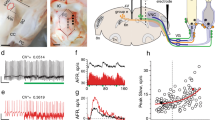Summary
Recordings were made from central vestibular neurons responding to horizontal head rotation in antarctic fish,Pagothenia borchgrevinki, at a temperature close to 0 °C. The spontaneous activity of these units varied between 0 and 56 Imp/s with a mean value of 20. Almost all units responded to horizontal rotation with a maximum firing rate that was approximately in phase with head velocity, either towards the recording side (type I units) or away from the recording side (type II), with no alteration of firing pattern during saccadic eye movements. The mean gain of these units was 2.6 Imp/s/ℴ/s at 0.35 Hz which is higher than that reported for central vestibular neurons in other fish.
Similar content being viewed by others
References
Allum JHJ, Graf W, Dichgans J, Schmidt CL (1976) Visualvestibular interaction in the vestibular nuclei of the goldfish. Exp Brain Res 26:463–485
Allum JHJ, Graf W (1977) Time constants of vestibular nuclei neurons in the goldfish: a model with ocular proprioception. Biol Cybern 28:95–99
Blanks RHI, Precht W (1976) Functional characterisation of primary vestibular afferents in the frog. Expl Brain Res 25:369–390
Buettner UW, Büttner U, Henn V (1978) Transfer characteristics of neurons in vestibular nuclei of the alert monkey. J Neurophysiol 41:1614–1628
Correia MJ, Landolt JP, Ni MD, Eden AR, Rae JL (1981) A species comparison of linear and nonlinear transfer characteristics of primary afferents innervating the semicircular canal. In: Gualtierotti T (ed) The vestibular system: function and morphology. Springer, Berlin Heidelberg New York, pp 280–316
Fuchs AF, Kaneko CRS, Scudder CA (1985) Brainstem control of saccadic eye movements. Annu Rev Neurosci 8:307–337
Gestrin P, Sterling P (1977) Anatomy and physiology of goldfish oculomotor system. II. Firing patterns of neurons in abducens nucleus and surrounding medulla and their relation to eye movements. J Neurophysiol 40:573–588
Hartmann R, Klinke R (1980) Discharge properties of afferent fibres of the goldfish semicircular canal with high frequency stimulation. Pflügers Arch 388:111–121
Korn H, Bennett MVL (1975) Vestibular nystagmus and teleost oculomotor neurons: functions of electrotonic coupling and dendritic impulse initiation. J Neurophysiol 38:430–451
MacDonald JA (1981) Temperature compensation in the peripheral nervous system: antarctic vs. temperate poikilotherms. J Comp Physiol 142:411–418
MacDonald JA, Montgomery JC (1982) Thermal limits of neuromuscular function in an antarctic fish. J Comp Physiol 147:237–250
Montgomery JC (1980) Dogfish horizontal canal system: responses of primary afferent, vestibular and cerebellar neurons to rotational stimulation. J Neurosci 5:1761–1769
Montgomery JC, Macdonald JA (1985) Oculomotor function at low temperature: antarctic versus temperate fish. J Exp Biol 117:181–191
Montgomery JC, McVean AR, McCarthy D (1983) The effects of lowered temperature on spontaneous eye movements in a teleost fish. Comp Biochem Physiol 75 A:363–368
D'Leary DP, Dunn RF, Honrubia V (1976) Analysis of afferent responses from isolated semicircular canal of guitarfish using rotational acceleration white-noise inputs. I. Correlation of response dynamics with receptor innervation. J Neurophysiol 39:631–644
Oman CM (1981) The influence of duct and utricular morphology on semicircular canal response. In: Gualtierotti T (ed) The vestibular system: function and morphology. Springer, Berlin Heidelberg New York, pp 251–274
Robinson DA (1981) The use of control systems analysis in the neurophysiology of eye movements. Annu Rev Neurosci 4:463–503
Schermuly L, Klinke R (1985) Change of characteristic frequency of pigeon primary auditory afferents with temperature. J Comp Physiol A 156:209–211
Author information
Authors and Affiliations
Rights and permissions
About this article
Cite this article
Montgomery, J.C., McVean, A.R. Brain function in antarctic fish: Activity of central vestibular neurons in relation to head rotation and eye movement. J. Comp. Physiol. 160, 289–293 (1987). https://doi.org/10.1007/BF00609734
Accepted:
Issue Date:
DOI: https://doi.org/10.1007/BF00609734




